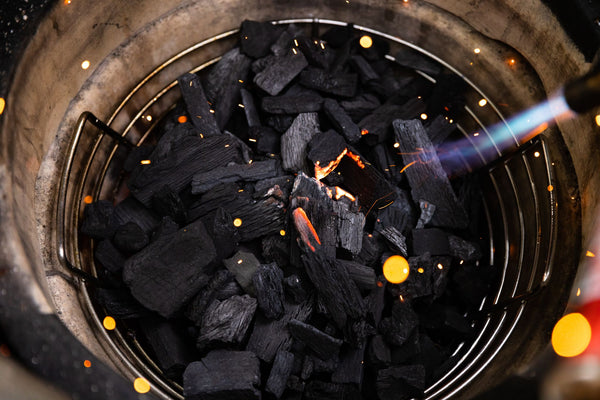
What is Korean BBQ?
Korean barbeque (KBBQ) has infiltrated the North American foodie scene, and it’s easy to see why. From restaurants to at-home, everyone is falling in love with the tender meats and sweet and spicy flavors that permeate the Korean BBQ table.
In this article, we’ll go through what Korean BBQ is, why we love it, and some popular (and easy) KBBQ recipes you can whip up at home.
What is Korean BBQ?
Korean BBQ originates in Korea, and it’s a cuisine focused on thinly-sliced, grilled meats with a savory-spicy tang. KBBQ has made its way to America not only for its flavors but also for its associated cultural experience. Korean BBQ is meant to be a collective experience, where friends and family come to cook and eat together. In restaurants, everyone will gather around a table with a grill in the middle, where they’re given raw meat and sides that they grill themselves. At home, a lot of traditionalists will have a similar setup with bowls of each ingredient and encourage guests to cook their own plates.
Whether you — the Master Griller — choose to do the cooking for your family or have everyone cook their own meats and sides, Korean BBQ is a delicious and rich experience that brings everyone together over the delights of a grilled meal. That’s one of our missions here at Kick Ash Basket: share experiences with loved ones over deliciously-grilled food.
How does Korean BBQ work?
Want to make your own Korean BBQ experience at home? With so many restaurants shut down, Korean BBQ businesses have been hit especially hard, since most of their grills are inside. To stay safe while getting your fill of this delicious cuisine, we’re going to give you some tips and tricks to set up your own KBBQ at home.
Charcoal Grill
Traditional Korean BBQs use charcoal grills for that smoky, rich flavor. That charcoal smoke is part of the charm and delectable gusto of Korean BBQ. Indoors, the charcoal grill is in the center of the table, with an exhaust fan above it. If you’re doing a KBBQ at home, just fire up your outdoor charcoal grill to medium-high heat and get to barbequing!
Any kind of charcoal grill can work for Korean BBQ, whether you have a Vision or Big Green Egg. Don’t forget your Kick Ash Basket to safely shake out charcoal and the Kick Ash Can to catch all the ashes for super-easy ash removal. This means you can safely clean up and keep on cooking all night long. (Korean BBQs are essentially all-you-can-eat buffets, so get ready to keep on grilling for your loved ones.)
Set Up the Stations
There are three main parts to a Korean BBQ: meat, sides, and drinks (Sounds like every good barbeque I’ve ever had!). You’ll want to prep all the meats and sides before cooking by putting them in individual containers or bowls. That way, your family members or guests can select what they’d look to cook. Even if you choose to do all the cooking (if others don’t feel comfortable or if you’re trying to maintain a socially-distant party), you can still let your family members pick what kind of food they’d like before you throw it on the grill.
Get the Drinks Ready
Before, during, and after your meal, you’re probably going to want to indulge in some delicious Korean drinks. The most popular Korean alcoholic beverages include:
-
Soju (basic rice wine); serve chilled in small glass with wide mouth
-
Takju (cloudy/unfiltered rice wine); also called makgeolli; serve in soup bowl; helps cut the spiciness of Korean food
-
Raspberry wine (bokbunja ju); after-dinner drink that lasts like fruit liqueur or port
-
Korean light beer
If you want to learn more, Esquire wrote up an extensive guide for traditional Korean rice alcohol. Also be sure to check out these Korean wine and drink pairings with meat.
Tools
There are other tools you may need or want for your at-home Korean BBQ:
-
Meat cutting scissors
-
Stainless steel mixing bowls
-
Non-stick stone bowls for serving
-
Stainless steel or wooden chopsticks
-
Korean BBQ rubs, marinades, and sauces
-
Instant pot or rice cooker
-
Cast iron skillet with hot handle holder (for easy grilling and serving)
-
Probiotic fermentation with inner vacuum lid (if you want to get real serious and make your own kimchi)

Popular Korean BBQ Recipes and Dishes
Meat
Meat is the main event of a Korean BBQ. All of the sides are made to compliment the rich, sweet flavors of the meat dishes. Charred meat and rendered fat are at the heart and soul of the beloved Korean BBQ tradition.
Beef and pork are the most common proteins used in Korean BBQ. Most Korean dishes use thin cuts of meat, so they’re fast and easy to cook at home. There are so many types of meats you’ll find in Korean dishes, but we’ll give you the most popular recipes (along with some of our favorites).
Pro-tip on grilling for Korean BBQ: the meat is ready to flip when water or “sweat” starts to pool on top.
Beef: Galbi and Bulgogi
The two most popular beef recipes are galbi (aka short ribs) and bulgogi (thin-sliced sirloin, brisket, or ribeye). These both pair beautifully with a soy sauce marinade that’s sweet and savory, with a gentle sesame oil aroma. The soy marinade is gentle, so it won’t overpower the smoky flavor of the meat on your charcoal grill.
This is one of the easiest and most-delicious galbi recipes we’ve seen. When choosing your cut, we prefer a flank-cut short rib. Short ribs cook quickly, so you’ll want to use a charcoal grill to get a nice sear on the outside.
The recipe is similar for a good bulgogi; the cut of the meat is just slightly different. It only takes a minute or two for these to cook on the grill, so be careful not to overcook them or they’ll dry out. We recommend using a mesh wire rack to prevent smaller pieces of the brisket from falling through the grates.
Pork: Dwaeji Bulgogi and Samgyeopsal-Gui
There are two pork dishes we can’t get enough of: dwaeji bulgogi and samgyeopsal-gui (aka pork belly).
Dwaeji bulgogi is the pork version of the bulgogi mentioned above, but this one is marinated in a spicy chili pepper paste (as opposed to the beef’s soy sauce paste). Paired with fresh garlic and ginger, this pork dish packs an aggressive and spicy punch that will delight your taste buds (if you enjoy a little spice). We love this dweji bulgogi recipe because the flavors are so potent and, well, just look at the picture of the sliced meat— that marbling makes my mouth water!
When I first tried samgyeopsal-gui, I was hooked. It has the meatiness of the pork belly with a sweet sauce that’s electric on the palate. Most people pan-fry this recipe, but you can throw it in a cast iron skillet and put it on the grill for a few minutes, too, if you want that scrumptious charred flavor. Here’s a delicious-yet-straightforward Korean pork belly recipe by Tasty.
Chicken: Buldak
Although chicken isn’t as common in KBBQ as beef or pork, we always like offering a grilled chicken dish. Buldak, translated to “fire chicken,” is a spicy chicken dish with a hint of sweetness. It uses a bone-in chicken thigh with sugary marinade covered in cheese… I mean, what more could you ask for? This cheesy buldak recipe is the most in-depth one we’ve found, and it gives great advice on how to prep your charcoal grill for an irresistibly-smoked chicken.
Sides
In every culture, grilled meat and vegetables are better together. In Korean, sides are referred to as “banchan.” These banchan sides are typically served before or with the main course. Common banchan include:
-
Fermented vegetables (like grilled cabbage kimchi and pickled radish)
-
Rolled omelets (gyeran mari)
-
Dried, stir-fried anchovies
-
Marinated greens (watercress or spinach)
-
Seasoned soybean sprouts
-
Mung bean jelly
-
Potato salad
-
Braised potato
-
Seaweed in sauce
Check out Thrillist’s awesome guide to banchan. Select a few to serve at your own KBBQ!
I cannot overstate this… Throw large chunks of kimchi on the grill. You will not regret it. The grill isn’t just for meat; a lot of Korean BBQ sides are even better grilled!
Sauce: Ssamjang
Ssamjang translates to “wrapped thick sauce,” because it’s used as the catch-all sauce for meats, sides, and lettuce wraps. It’s the sauce that goes with everything at a Korean BBQ. It’s a blend of doenjang (soybean paste) and gochujang (chili paste). With toasted sesame oil and seeds, fresh garlic, and scallions, this sweet heat sauce is the taste we think of when we think Korean BBQ. Check out this stir-together ssamjang dipping sauce recipe that you will love with pork belly, bulgogi, or even right on a spoon.
This might even become your go-to BBQ sauce recipe!
Garnishes
Every Korean BBQ needs greenery, rice, and garnishes.
The greenery serves as a wrapper for grilled meats and sauce, while adding a crispness and palate cleanser. For a traditional feast, you’ll want to offer both lettuce and perilla leaves. Red leaf or Bibb lettuce are the best, since they’re tough but flexible. Perilla leaves are “sesame leaves” with a grassy taste that beautifully accentuates the rich flavors of the pork and beef.
Rice is a core component to a Korean meal. Although it can take a while to cook, it’s a staple that’s used to pull out the meaty flavors, cool down the spice, and add some carbs to the meal. Learn how to make the perfect Korean steamed rice here.
Ssam garnishes are an essential in Korean BBQ. They help make the dish your own! Common Korean garnishes to have available at your party include: fresh green Korean chilies, sliced garlic cloves, scallions, toasted sesame seeds, lime, beet juice, soy sauce, sriracha, and more.
What is Korean BBQ?
If you’re looking to try something new, Korean BBQ brings delicious flavors right to your very own charcoal grill. If you like spicy paired with a zest of sweetness and tang, you will adore Korean BBQ. Plus, it’s healthy, easy to whip up, budget-friendly, and a great way to get everyone bonding over cooking & eating delicious food!
Korean BBQ is best over a charcoal grill. So get all your Kick Ash Basket products ready, like the charcoal basket, ash-catching can, and charcoal prep gloves, so you can safely and easily grill up a buffet of chopstick-licking-good BBQ.


